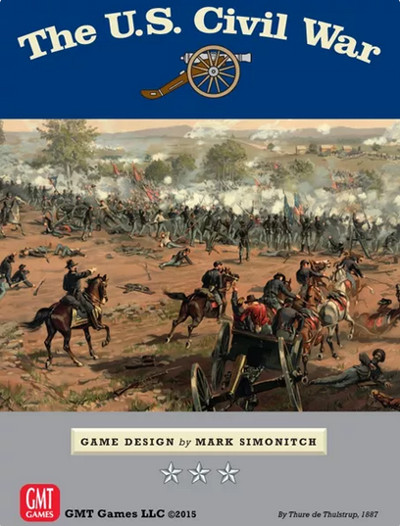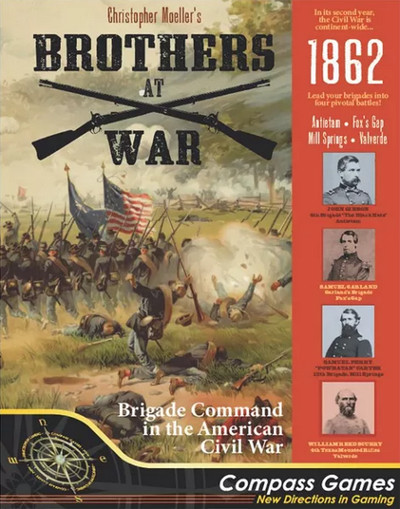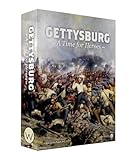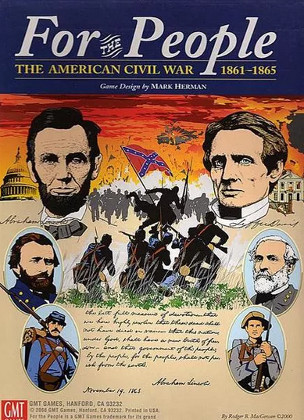American Civil War board games recreate the historic conflict through various gameplay formats, from grand campaigns to intimate battlefield encounters.
This article explores a variety of board games centered around the American Civil War, highlighting how they recreate the historical conflict through different gameplay styles and mechanics. It provides an overview of strategic elements, player interactions, and the immersive experiences these games offer, allowing players to engage with pivotal moments in American history. Whether through complex simulations or streamlined tactical encounters, these games invite players to step into the shoes of military leaders and navigate the challenges of the era.
The U.S. Civil War (2015)
The U.S. Civil War, released in 2015, is a strategic board game that recreates the American Civil War through an intricate military simulation system.
This two-player experience unfolds on two mounted maps measuring 30 by 44 inches, covering the Southeastern United States. Playing time ranges from 3-4 hours for shorter scenarios to 10-12 hours for the full campaign. The game mechanics center on strength point allocation, where each point represents 5,000 soldiers, commanded by historical generals. Players alternate through four distinct Action Phases per seasonal turn, with each turn spanning two to three months of historical time.
- Package Quantity: 1
- Excellent Quality.
- Great Gift Idea.
- Satisfaction Ensured.
- Produced with the highest grade materials
The core system immerses players in period-specific military operations through multiple layers: naval warfare with ironclads, fort management, leader promotion tracks, and commerce raiding missions. Special Action Cards, consisting of a 30-card deck, drive strategic decisions and historical events. Combat resolution involves detailed calculations of force ratios, terrain effects, and leadership qualities.
Three shorter scenarios focus on specific years (1861, 1862, and 1863), while the grand campaign covers the entire conflict. The game’s components include comprehensive rulebooks, player aid cards, scenario cards, and detailed combat tables. The design draws direct influence from previous Civil War simulations, particularly Eric Lee Smith’s The Civil War and Mark Herman’s For the People, refining their concepts into a deeply tactical experience that pulls players into the complex decision-making of Civil War leadership.
Brothers at War: 1862 (2022)
Brothers at War: 1862, released in 2022, brings tactical Civil War combat to the tabletop through a series of major battles from that pivotal year.
The game features four distinct battles – Antietam, South Mountain, Mill Springs, and Bloody Valverde – each played on a 22×34″ map with 1.5-inch hexes. Designed for 1-2 players with playtimes ranging from 60 to 240 minutes, the game utilizes a streamlined combat system that replaces traditional Combat Results Tables with six-sided dice mechanics. Players need to roll 5-6 for success, while 1-4 results in failure.
Unit management forms the core gameplay experience, with players controlling infantry (in formed or unformed states), artillery (deployed or limbered), and cavalry (mounted or dismounted). Though unit facing isn’t a primary mechanic, tactical depth emerges through pass-through fire rules and positioning.
The Battle Card system introduces strategic variability, while dedicated displays track brigade reserves and casualties. Historical authenticity shapes gameplay through period-specific unit capabilities and restrictions. The game achieves medium-high complexity with built-in solitaire support, offering multiple scenarios that reflect actual Civil War combat dynamics.
Each battle scenario maintains unique victory conditions and setup requirements, with detailed terrain effects impacting movement and combat. The command and control system requires careful management of brigade cohesion and morale, creating tension between aggressive tactics and unit preservation.
American Civil War (2018)
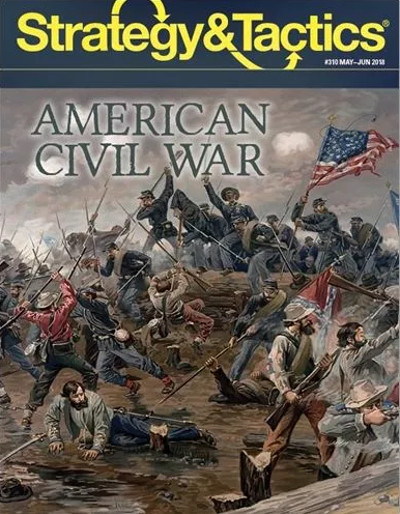
American Civil War (2018) is a strategic wargame published by Decision Games in Strategy and Tactics issue 310, reimagining their 1974 classic title about the American Civil War.
The game supports 2 players controlling either the Union or Confederate forces on a 22″ x 34″ map with 280 counters. A typical game session lasts between 2-4 hours. The core gameplay revolves around a two-impulse system per quarterly turn, where players:
- Recruit and deploy military units
- Move forces across territories
- Initiate and resolve combat encounters
- Manage economic resources
- Handle political stability
The Confederate player begins with superior military leadership qualities but faces mounting economic pressure. Their strategy requires balancing defensive positioning with selective counterattacks while maintaining political cohesion. The Union player starts with inferior commanders but can improve their effectiveness through combat experience, even if early battles result in defeats.
Combat resolution incorporates terrain effects, force ratios, and leadership quality. The reactive combat system allows defenders to attempt withdrawals or counterattacks. Movement mechanics feature extended operational reach through railroads and naval transport, with weather impacting mobility.
Victory assessment occurs each turn, factoring in territorial control, economic stability, and political developments. The Union’s progress directly affects political support for the war effort, while Confederate survival depends on maintaining territorial integrity and international recognition.
The Civil War 1861-1865 (1983)
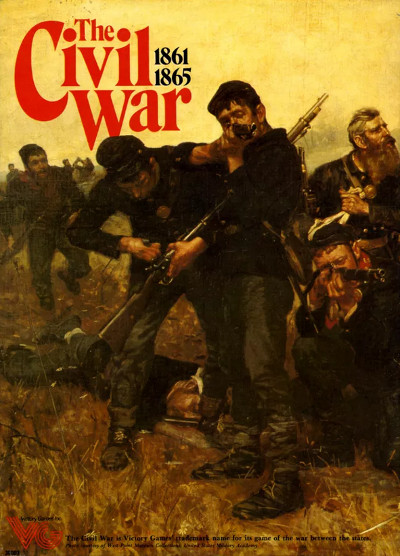
Victory Games’ The Civil War 1861-1865 stands as a strategic board game that brings the American Civil War to the tabletop. This two-player wargame typically runs between 6 to 40 hours, depending on the scenario chosen.
The gameplay operates on a hex-based map spanning from the Eastern seaboard to Texas, with an optional New Mexico extension, utilizing a 25-mile per hex scale. Players engage in simultaneous planning phases followed by alternating action sequences, managing three distinct theaters of war (East, West, and Trans-Mississippi). Each theater must be designated as primary, secondary, or tertiary at the start of every turn, directly affecting resource allocation.
The game’s engine runs on Command Points, which players spend to activate military units, construct fortifications, and initiate naval operations. The innovative Pulse system determines action sequences through dice rolls, creating unpredictable turn lengths and tactical opportunities. Players command over 60 historical leaders, each with unique ratings for command ability, initiative, and combat effectiveness.
Combat resolution involves Strength Points (each representing 5,000 troops or a naval squadron) and utilizes a detailed combat results table that accounts for terrain, fortifications, and leadership quality. The game’s 520 counters include infantry, cavalry, artillery, and naval units, with specific rules for riverine operations, blockades, and amphibious assaults. Naval warfare mechanics encompass ironclad battles, coastal operations, and strategic movement along rivers, making it a comprehensive simulation of both land and sea operations during the Civil War period.
For the People
For the People (1998) is a card-driven wargame designed by Mark Herman that recreates the American Civil War. This two-player strategy game puts one player in command of the Union forces as President Lincoln while the other leads the Confederacy as President Davis.
The game features:
- A strategic card system with 130 unique cards depicting historical events and personalities
- A mounted point-to-point map representing the theater of operations
- 420 counters representing military units and markers
- 360-minute average playing time
- Each strength point represents 6,000 soldiers
Players engage in detailed military operations including:
- Amphibious assault planning and execution
- Cavalry raid coordination
- Strategic army movements
- Naval blockade implementation
- Ironclad vessel construction
- Foreign intervention attempts
The political layer involves:
- Cabinet member selection and management
- General officer appointments and dismissals
- Diplomatic relationship handling
- Resource allocation decisions
Each four-month game turn enables players to experience the complex decision-making that characterized the Civil War leadership. The integrated card system drives both military operations and political events, requiring careful hand management and strategic timing.
The naval aspect incorporates both Union blockade efforts and Confederate attempts to maintain supply lines, while the political mechanics reflect the delicate balance between military necessity and civilian governance.
Altar of Freedom: Grand Tactical Battles in the American Civil War (2013)
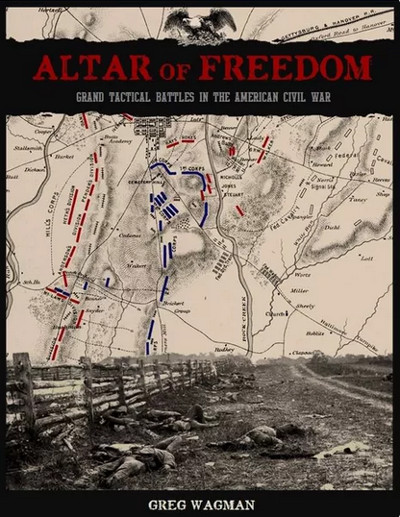
Altar of Freedom is a grand tactical wargame that recreates major American Civil War battles using miniatures, where players take command at corps and army level rather than managing individual units.
The game’s core mechanism revolves around the Turn Clock and Priority Points system. At the start of each turn, players bid Priority Points to determine activation sequence, creating tactical depth as commanders must carefully manage their points throughout the battle. One turn represents an hour of combat, with precise ground scale measurements of 1 inch equaling 150+ yards on the tabletop. Each base represents a brigade-sized formation, maintaining consistent command ratios.
The Priority Point bidding mechanism unfolds in three phases:
- Initial bidding phase
- Counter-bid opportunity
- Final activation sequence determination
The system supports 2-4 players with games lasting 2-4 hours depending on scenario size. Players can choose from historically-based battles including Antietam, Gettysburg, and Chickamauga. The rules accommodate multiple miniature scales (6mm to 15mm), with comprehensive army lists providing detailed force composition guidelines.
Victory conditions mirror actual battlefield objectives, with point-based scoring tied to geographic locations, casualties inflicted, and specific military goals achieved during each scenario. The command system immerses generals in period-accurate decision making, while the flexible scale allows players to use existing miniature collections.
Washington’s War (2010)
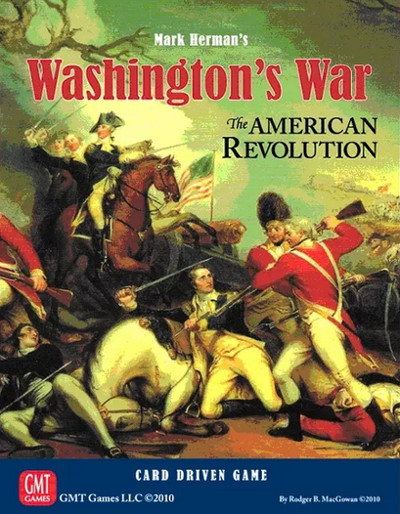
Washington’s War is a card-driven board game that recreates the American War of Independence through military and political strategy. This redesign of We the People places two players in command of opposing forces – the British Empire and the American Continental Army.
Players engage in an asymmetrical conflict that typically concludes within 90 minutes. The British player commands traditional military forces with superior naval capabilities in coastal areas, while the American player relies on guerrilla tactics and militia mobility across the colonies.
The game mechanism centers on:
- A card-driven system where each card can be used for either movement, combat, or special events
- A dice-based combat resolution that factors in force strength, terrain, and leadership
- A unique discard pile mechanic allowing players to purchase previously used event cards
- Political control markers representing influence over colonial territories
- Naval movement rules giving the British player coastal superiority
- Militia recruitment options providing Americans with flexible force deployment
Game components include:
- Mounted game board depicting colonial America
- Event cards with historical actions and scenarios
- Military unit tokens for both British and Continental forces
- Political control markers
- Combat dice
- Comprehensive rulebook
The design underwent extensive tournament testing to ensure competitive balance and clear rules interpretation, making it suitable for both casual and competitive play in face-to-face or online formats.
A House Divided: War Between the States 1861-65 (1981)
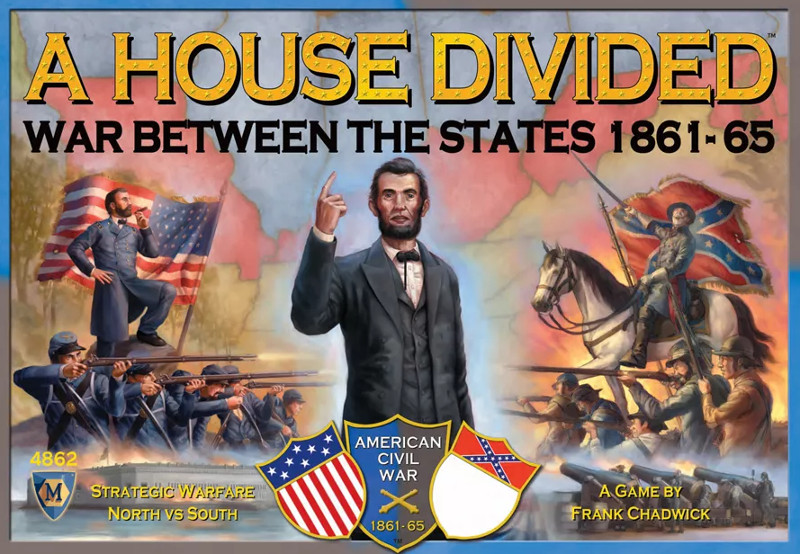
A House Divided recreates the American Civil War as a strategic board game, from Bull Run to Appomattox Courthouse, where players lead either Union or Confederate forces.
This two-player wargame requires approximately 240 minutes to complete and is designed for ages 12 and above. The gameplay unfolds on a strategic map composed of interconnected boxes that represent cities and key locations across the divided United States. Movement occurs through three distinct transportation networks: blue-marked river routes, tan-colored roads, and black railroad lines.
Players must carefully manage their forces by:
- Controlling cities for victory points and resources
- Maintaining supply lines through connected territories
- Utilizing multimodal transport options (water, rail, road)
- Coordinating offensive and defensive operations
- Managing troop deployments across the theater
The game immerses players in historical authenticity through detailed state rights considerations, slavery issues, and the North-South dynamics of 1861-1865. The system allows commanders to explore alternative outcomes, including potential Confederate victory scenarios through strategic objectives like capturing Harrisburg. Each element on the board – from supply routes to city control points – directly impacts military operations and strategic planning, drawing players into the complex logistical challenges that defined the actual conflict.
Brigade Fire and Fury: Wargaming the Civil War with Miniatures (1990)
Brigade Fire and Fury, released in 1990, is a miniature wargaming system recreating American Civil War battles at the brigade level. Each game represents a specific engagement, with stands of miniature soldiers portraying military units on historically accurate terrain.
The system incorporates these specific components:
- A complete rulebook with quick reference sheets for efficient gameplay
- Detailed guidelines for painting and assembling military units
- Multiple scenarios focusing on the Battle of Gettysburg
- Ground scale of 1 inch = 25-30 yards
- Each stand represents 150-200 soldiers
- Unit formations of 4-14 stands per brigade
- Turn sequence representing 30-minute intervals of combat
Player count ranges from 2-12, with optimal gameplay occurring between 3-6 participants. A typical scenario takes 3-4 hours to complete, not including setup time. The alternating activation system requires players to carefully manage their forces – Union commanders must leverage their superior firepower and artillery, while Confederate players often employ aggressive tactics and decisive charges to overcome their technological disadvantage.
The game mechanism emphasizes command decisions through:
- Formation changes affecting unit effectiveness
- Morale checks after significant casualties
- Supply line maintenance
- Artillery placement and ammunition management
- Terrain effects on movement and combat
- Weather conditions impacting visibility and operations
Setup time varies based on scenario size, typically ranging from 30-60 minutes for experienced players working with pre-painted miniatures.
The Price of Freedom: The American Civil War 1861-1865 (2008)
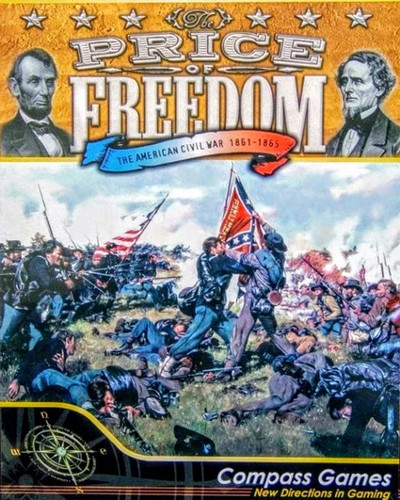
The Price of Freedom: The American Civil War 1861-1865 offers a strategic simulation of America’s deadliest conflict. This two-player wargame delivers a complete Civil War experience in approximately three hours.
The game’s core mechanics revolve around a card-driven system containing 55 unique cards. Each card presents players with two choices: execute operational actions or trigger specific historical events. Military operations unfold through corps-level unit counters that players must organize into armies, each led by historically accurate commanders. Movement occurs on a point-to-point map system spanning both Eastern and Western theaters of war.
The War Effort mechanic serves as a central feature, directly impacting army sizes and the number of cards players can hold in their hands. Combat resolution incorporates commander ratings, terrain effects, and supply considerations, while political decisions influence military capabilities and resource allocation.
Victory can be achieved through multiple paths. Union players win by either diminishing the Confederate War Effort track or establishing clear military dominance on the map. Confederate players can triumph by maintaining their War Effort, achieving battlefield superiority, or successfully swaying the outcome of the 1864 presidential election. Each decision immerses players in the complex military-political landscape of 1860s America, while the dual-use card system creates constant strategic tension between immediate tactical needs and longer-term objectives.
The Lost Cause: The American Civil War, 1861-1865 (2010)
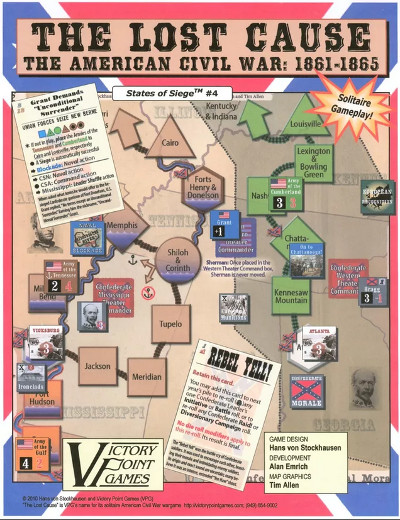
The Lost Cause: The American Civil War transports players to the Confederate command, where they must defend against advancing Union armies in this solitaire wargame. As Jefferson Davis, players coordinate responses across multiple fronts while managing dwindling Southern resources.
This States of Siege title employs a card-driven system featuring Headline and Broadsheet Event cards that shape the narrative and tactical options. The game operates on a monthly turn structure, with each session lasting between 60 minutes for basic scenarios and 90 minutes for advanced play. Players must respond to Union advances from five different directions while managing:
- Land battle coordination
- Naval blockade operations
- International diplomatic efforts
- Home front stability
- Resource allocation
- Military leadership assignments
The game system incorporates historically accurate Confederate commanders, including Robert E. Lee and Joseph Johnston, each with unique abilities affecting combat outcomes. With a complexity rating of 3.5 to 5 on a 9-point scale, and a perfect 9/9 solitaire suitability rating, The Lost Cause demands careful strategic planning.
Key mechanical elements include:
- Single-player only design
- Card-driven events
- Point-to-point movement system
- Resource management mechanics
- Multiple scenario options
- Variable difficulty settings
- Monthly turn sequence
- Five-front defensive gameplay
The detailed command structure and multi-front crisis management immerses players in the strategic challenges faced by the Confederate leadership during the Civil War years.
Lincoln’s War (2013)
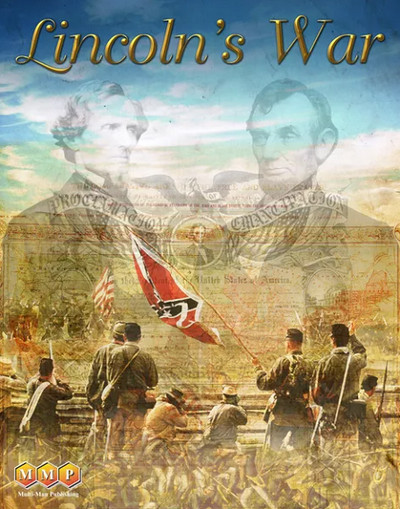
Lincoln’s War is a card-driven board game set during the American Civil War that combines political and military decision-making.
The game supports one to four players with a playing time of 180 minutes. At its core, the Political Currency (PC) system drives all major actions – from activating generals in the field to promoting commanders and purchasing essential war materials. Players must maintain their PC above zero at the end of each turn or face immediate defeat, regardless of their military position.
The design employs a diceless combat resolution system and features seditious characters who can weaken presidential control. Players navigate through military operations using the 22″ x 34″ map board while managing their hand of 162 Operations Cards. The game includes immobilization tokens to represent both battlefield losses and command challenges.
Designer John Poniske, with Mike Joslyn’s development support, created a system where players must balance their resources between the battlefield and political sphere. Each turn presents choices between strengthening military positions and maintaining political support, while seditious elements threaten to undermine authority. The Operations Cards serve multiple functions – they can be played for their event text, used to generate Political Currency, or activated for military operations, forcing players to make tactical decisions with each card draw.
Bobby Lee: The Civil War in Virginia 1861-1865 (1993)
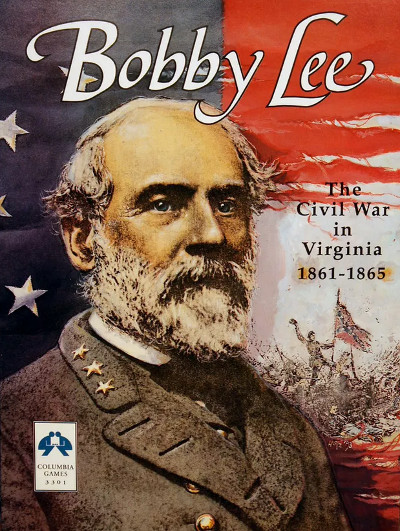
Bobby Lee is a two-player strategic board game depicting the Civil War’s eastern theater campaigns in Virginia. The game uses Columbia Games’ block system on a card-stock map covering Maryland, Pennsylvania, and Eastern Virginia.
The core gameplay revolves around wooden blocks representing military units, which remain hidden from the opponent until combat occurs, creating authentic fog of war conditions. Each block can rotate through four strength levels, accurately tracking casualties and unit deterioration. Combat resolution employs a distinctive formation system where players must position their forces in center and flank positions, replicating period military tactics.
Detailed Game Specifications:
- Player Count: 2 players
- Playing Time: 4 hours
- Components: Wooden blocks, card-stock map, dice
- Scale: Strategic/Operational level
- Area Movement: Units move between connected regions
- Combat System: Formation-based with center/flank positioning
- Supply Lines: Must be maintained to prevent unit attrition
- Reinforcement System: Historical scheduling of troops
- Victory Conditions: Multiple paths based on territorial control and army preservation
The battle system allows commanders to execute flanking maneuvers, defensive formations, and strategic withdrawals. When paired with Sam Grant, players can experience the entire Civil War theater. The wooden block system creates tension during movement and engagement phases, as players must deduce enemy strength and positioning through limited intelligence.
Each turn represents one month of campaign time, with seasonal effects impacting movement and supply capabilities. The game mechanics emphasize the period’s command and control limitations while maintaining historical authenticity in troop deployments and battle outcomes.
Blue vs. Gray (1999)
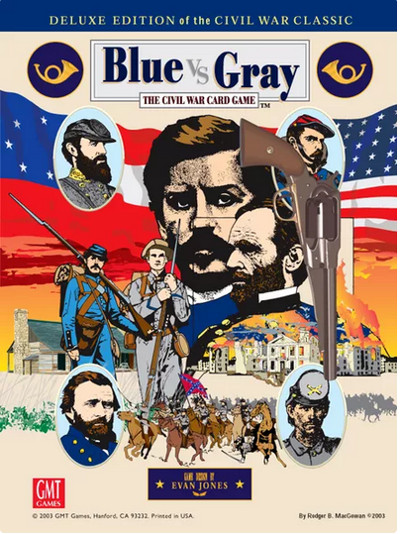
Blue vs. Gray (1999) is a card-driven wargame simulating the American Civil War through strategic card play and territorial control.
The game utilizes two specialized 100-card decks, separately representing Union and Confederate forces. Each deck contains unique military leaders, combat units, and historical events specific to their respective sides. Players progressively reveal the Southern United States map through strategic card placement, creating an expanding battlefield as the game unfolds. The command structure requires careful management of supply lines, with players positioning troops while considering logistics and geographical advantages.
Gameplay accommodates 2-4 players and typically concludes within one evening session (approximately 2-3 hours). Historical figures like Stonewall Jackson and William Sherman appear as playable cards with specific abilities that influence military operations. The command system involves multiple decision points: players must coordinate troop movements, maintain supply routes, and execute battlefield tactics using their hand of cards.
The non-collectible format includes all necessary components in the base game, eliminating the need for additional card purchases. Designed for ages 12 and up, the game combines precise historical detail with clear mechanical systems. Each turn presents players with strategic choices about resource allocation, territorial expansion, and military engagement, while the card-based mechanics ensure varied gameplay scenarios across multiple sessions.
